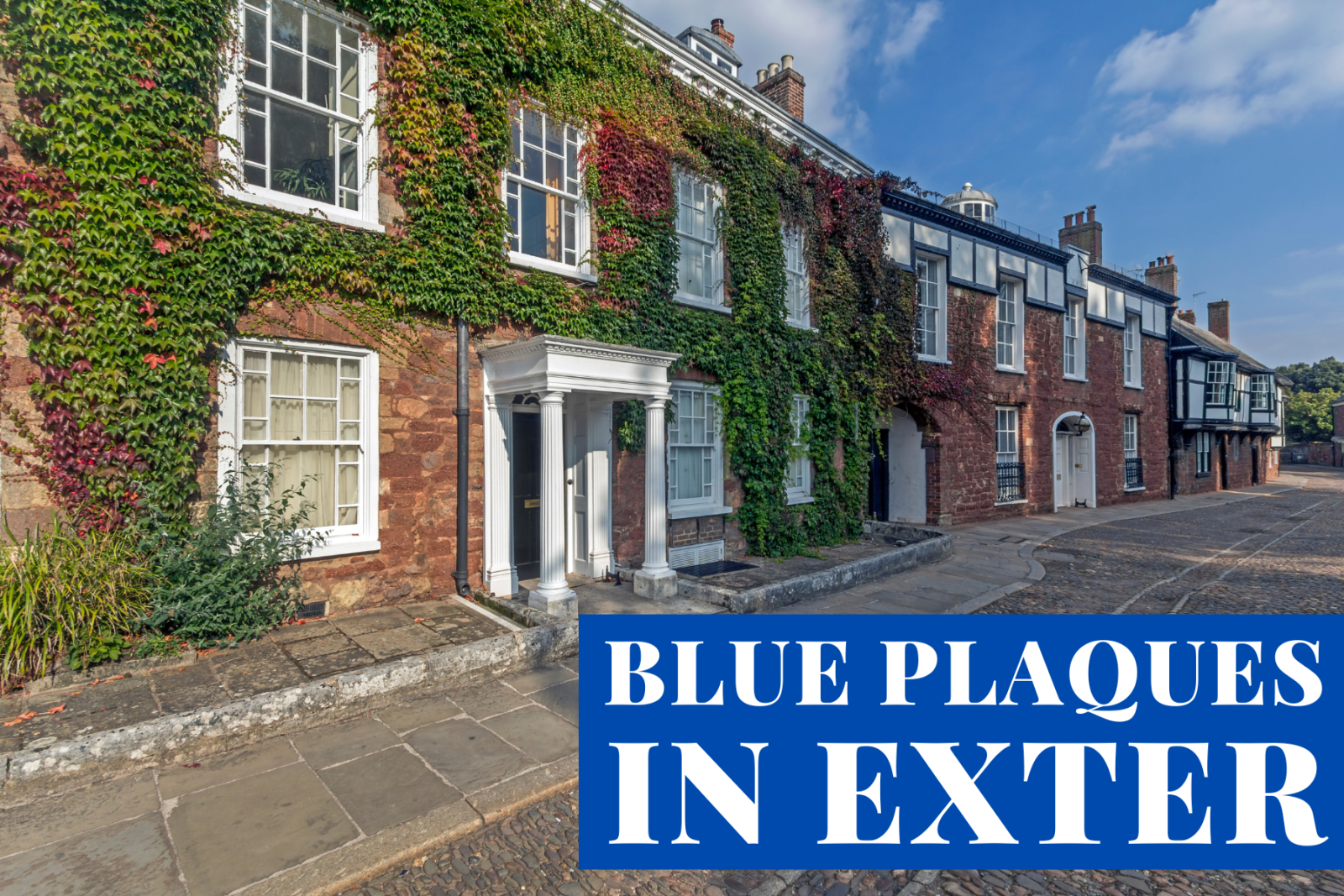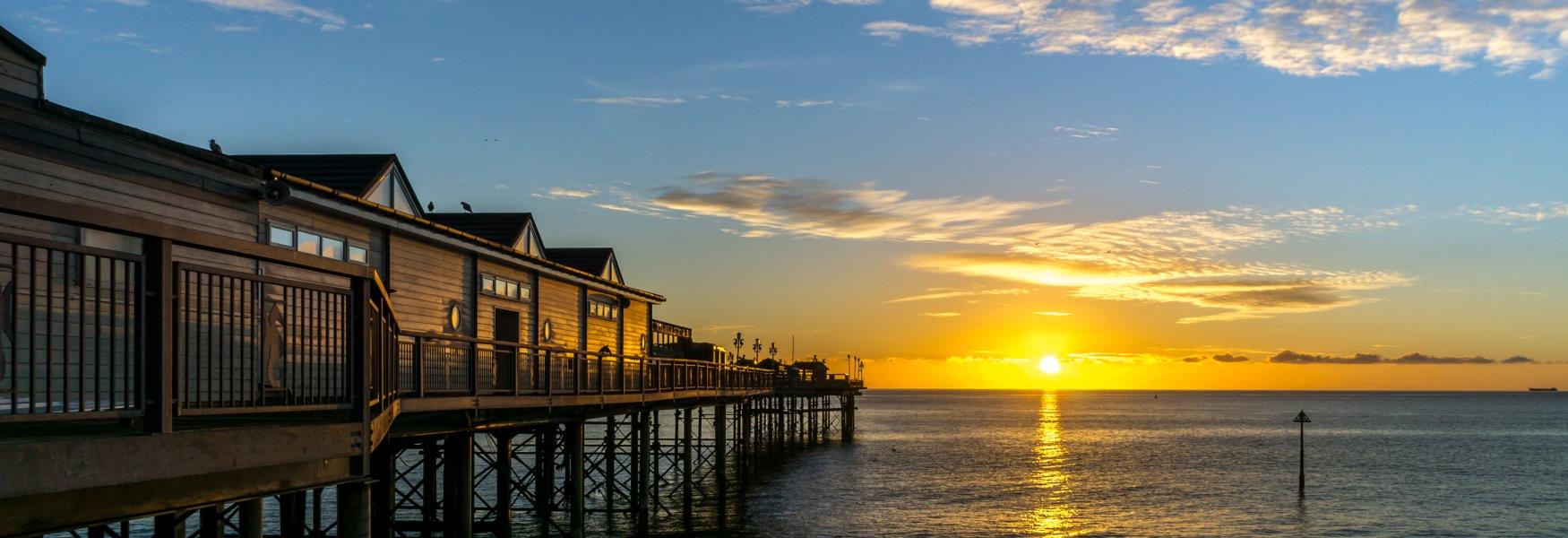 Blue Plaques are permanent signs installed by The English Heritage Scheme in public places to act as a historical marker to commemorate a link between that particular location and a famous or historic event, person, or former building on the site. South Devon is not short of these shiny blue plaques; in fact, we have over 20 in Exeter alone. The city also boasts several other notable plaques which are recognised by Exeter Civic Society which highlight Exeter’s historic importance. Read on for a list of all the blue plaques in Exeter.
Blue Plaques are permanent signs installed by The English Heritage Scheme in public places to act as a historical marker to commemorate a link between that particular location and a famous or historic event, person, or former building on the site. South Devon is not short of these shiny blue plaques; in fact, we have over 20 in Exeter alone. The city also boasts several other notable plaques which are recognised by Exeter Civic Society which highlight Exeter’s historic importance. Read on for a list of all the blue plaques in Exeter.
Corner of Gandy Street & High Street (EX4 3NE)
Sir Thomas Bodley, scholar, diplomat and founder of the Bodleian Library in Oxford was born here on 2nd March 1545. He was also the son of John Bodley, publisher of the Geneva Bible. As well as Sir Thomas Bodley, John Shillingford, mayor, and MP also lived here.
82 Longbrook Street (EX4 6AP)
There are two plaques at this address. The first commemorates the childhood home, which was previously known as 9 Park Place, of William Kingdon Clifford, who was a mathematician and philosopher, born March 1845. The second plaque Is dedicated to Harry Hems, the ecclesiastical sculptor who lived here from 1885 – 1916.
Corner of Southernhay East & Barnfield Road (EX1 1QP)
This blue plaque was erected in memory of The Revd Theodore Bayley Hardy VC DSO MC, Chaplin to the King, who was born at Barnfield House in October 1863.
Gandy Street (EX4 3LS)
Gandy street was the childhood home of both Colonel David Collins RM, the first Judge Advocate of New South Wales (1788 – 96) and first Lieut. Governor of Tasmania (1804 – 1810). It was also the childhood home of George P. Harris, first Deputy Surveyor General of Tasmania (1804 – 1810) with Colonel Collins at Port Phillip.
143 Fore Street (EX4 3AN)
The novelist Charles Dickens (1812 – 1870) stayed here at the home and print works of Thomas Latimer (1803 – 1888), campaigning journalist in the 1800s.
St Sidwell’s Churchyard, Sidwell Street (EX4 6NE)
The plaque on the wall of St Sidwell’s Church commemorates the resting place of Peter Hennis, a much admired and revered physician and the hero of the Exeter cholera outbreak of 1832 who died following a duel on Haldon Racecourse in 1833.
St David’s Hill (EX4 4DA)
W. G. Hoskins (1908 – 1992), historian of Devon, Exeter and the English landscape was born here in 1908.
Royal Clarence Hotel, Cathedral Yard (EX1 1HD)
Hungarian pianist and composer Franz Liszt gave two recitals here on successive days in August 1840. Unfortunately, the hotel was severely damaged in a fire in 2016, but the plaque is still in place on what remains of the hotel’s façade, but it may be difficult to view because of the rebuilding work.
12 – 14 Cathedral Close (EX1 1EZ)
The first lieutenant governor of upper Canada (present day Ontario) John Graves Simcoe attended Exeter Free Grammar School in his early youth and died in a house on this site. He’s buried at Wolford Chapel in Dunkeswell near Honiton.
Gatehouse, Rougemont Castle, Castle Street (EX4 3PU)
The plaque here commemorates the ‘Devon Witches,’ Temperance Lloyd, Susannah Edwards, Mary Trembles and Alice Molland, the last people in England to be executed for witchcraft. They were tried here and hung at Heavitree in the 1860s.
11 Howell Road (EX4 4LG)
This location was the home for 49 years of Frederick George Widgery a landscape painter and Freeman of Exeter, best known for his paintings of Dartmoor and the West Country coastline.
Walkway between Roman Walk & Southernhay (EX1 1TS)
The blue plaque here commemorates stage and screen stars Violet and Irene Vanbrugh. Violet Vanbrugh was born in a house near this site in 1867 and her sister Dame Irene Vanbrugh at Heavitree Vicarage in 1872.
11 Elm Grove Road (EX4 4LL)
Robert Veitch (1823 – 1885) was a member of the Veitch family dynasty of pioneering horticulturists who introduced hundreds of new plants and flowers from around the world into people's gardens, conservatories, and homes. He lived here from 1865 – 1884.
Clyde House, 16 Princes Street South (EX2 9AW)
This blue plaque was placed to commemorate Harry Weslake (1897 – 1978) an inspired engineer whose revolutionary designs gave car, motorcycle and planes more power. He lived here from 1908 – 1919.
Bellair, County Hall, Topsham Road (EX2 4PS)
Dame Georgiana Buller, daughter of General Sir Redvers Buller, whose statue stands at the top of St David’s Hill, lived here in the 1900s. Despite her father’s status, she made a name for herself by raising money for military hospitals in Exeter and was made a Dame in 1920.
1 Barnfield Crescent (EX1 1QJ)
The blue plaque here commemorates Elsie Knocker, Paroness de T’Serclaes (1884 – 1978), a nurse and ambulance driver on the front line in Pervyse and Marir Chisholm, who was born here.
58 West Street (EX1 1BB)
Commemorating Cecil ‘Charlie’ Brewer, this blue plaque has been placed in honour of the wartime pigeon Mary who won the Dickin Medal for bravery.
Corner of King Street & Stepcote Hill (EX1 1AT)
The plaque located at Kings Dwellings, King Street reads; Dr C. N. Lovely (1864 – 1947), general practitioner and social reformer, founding chairman of the Exeter workmen’s dwellings company which built over 500 homes in Exeter between 1926 – 1939.
Guildhall Shopping Centre (EX4 3HP)
Nicholas Hillard was a British Artist whose examples of work is held by The Royal Collection, the National Portrait Gallery, the Victoria and Albert Museum and various other galleries in the UK and abroad. The blue plaque here commemorates Nicholas, who previously owned the St Pancras Church (close to the Guildhall Shopping Centre) and were patrons of the living St Pancras.
Tregear, Spicer Road (EX1 1SJ)
This blue plaque was placed here as recognition for Stephen Simpson (1869 – 1954) an engineer, inventor and chairman of Willey and Co. of Exeter, benefactor of the reconstruction of Exeter Cathedral during and after the Second World War, who lived here from 1899 – 1912.
33 Herschell Road (EX4 6LX)
Edith Splatt (1889 – 1945) lived here until the end of her life. She was the first woman to be elected as a Councillor of Exeter City Council, representing Belmont ward as an independent from 1921 until 1945. She was a strong supporter of woman’s suffrage and worked for the Express and Echo.
Redvers, Alphington Street, St Thomas (EX2 8HN)
The first woman to represent the Labour Party for Exeter City Council, Rachel Allen lived at Redvers from 1924 until her death. She also founded the Exeter and District Women’s Welfare Association, which set up a number of women and children’s health clinics in the city.
Chichester Place, 16 Southernhay East (EX1 1NX)
Commemorating Sabine Baring-Gould, the plaque here lies to honour this writer who was born in Chichester Place in 1834.
28 Bartholomew Street West (EX4 3BN)
The plaque here serves as an honour for Abraham Cann (1794 – 1864) the champion of England at Devonshire Wrestling and landlord of the Champion’s Arms public house on this site between 1828 – 1830. The plaque was unveiled by Abbie Cann, a descendant of the Cann family of Colebrook.
That’s all the blue plaques in Exeter! This is the second in our series of blog posts detailing blue plaques, you can find a list of blue plaques in Paignton here. To find out when we’ll be posting our next blue plaque blog post make sure you sign up to our e-newsletter here or follow us on Facebook, Twitter, and Instagram.
Related
Comments
Comments are disabled for this post.



 to add an item to your Itinerary basket.
to add an item to your Itinerary basket.









